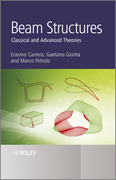
Beam structures: classical and advanced theories
Carrera, Erasmo
Giunta, Gaetano
Petrolo, Marco
Present a new, unified approach to both classical and advanced beam theory that is becoming established and recognised globally as the most important contribution to the field in the last quarter of a century Beam Structures: Classical and Advanced Theories proposes a new original unified approach to beam theory that includes practically all classical and advanced models for beams and which has become established and recognised globally as the most important contribution to the field in the last quarter of a century. This approach overcomes the problem of classical formulae that require different formulas for tension, bending, shear and torsion; it can be applied to any beam geometries and loading conditions, reaching a high level of accuracy, and can tackle problems that in most cases are solved by employing plate/shell and 3D formulations. Beam Structures: Classical and Advanced Theories presents both the classical and advanced beam theories in a form that is very suitable for computer implementation It is accompanied by dedicated software MUL2 that is used to obtain the numerical solutions in the book, allowing the reader to reproduce the examples given in the book as well as to solve other problems of their own. The authorsalso include a number of static and dynamic problems and solutions that serveto further illustrate the advanced theories presented. ÍNDICE: Preface. Introduction. References. 1 Fundamental Equations of Continuous Deformable Bodies. 1.1 Displacement, strain and stresses. 1.2 Equilibrium Equations in term of Stress Components and Boundary Conditions. 1.3 Strain Displacement Relations. 1.4 Constitutive Relations: Hookes Law. 1.5 Displacement Approach via Principle of Virtual Displacements. References. 2 The Euler-Bernoulli and Timoshenko Theories. 2.1 The Euler-BernoulliModel. 2.1.1 Displacement field. 2.1.2 Strains. 2.1.3 Stresses and stress resultants. 2.1.4 Elastica. 2.2 The Timoshenko Model. 2.2.1 Displacement Field. 2.2.2 Strains. 2.2.3 Stresses and stress resultants. 2.2.4 Elastica. 2.3 Bending of a cantilever beam:EBBT and TBT solutions. 2.3.1 EBBT solution. 2.3.2 TBT solution. References. 3 A refined beam theory with in-plane stretching: the complete linear expansion case, CLEC. 3.1 The CLEC displacement field. 3.2 The importance of linear stretching terms. 3.3 A Finite Element based on CLEC. Further Readings. 4 EBBT, TBT, and CLEC in Unified Form. 4.1 Unified Formulation of CLEC. 4.2 EBBT and TBT as particular cases of CLEC. 4.3 Poisson Locking and its Correction. 4.3.1 Kinematic considerations on strains. 4.3.2 Physical considerations on strains.4.3.3 First remedy: use of higher-order kinematics. 4.3.4 Second remedy: modification of elastic coefficients. References. 5 Carrera Unified Formulation and Refined Beam Theories. 5.1 Unified Formulation. 5.2 Governing Equations. 5.2.1 Strong Form of the Governing Equations. 5.2.2 Weak Form of the Governing Equations. References. Further Readings. 6 The parabolic, cubic, quartic and N-order beam theories. 6.1 The second-order beam model, N = 2. 6.2 The third-order, N = 3, and the fourth-order,N = 4, beam models 6.3 N-order beam models. Further Readings. 7 CUF Beam Finite Element Models: Programming and Implementation Issue Guidelines. 7.1 Preprocessing and Input Descriptions. 7.1.1 General FEInputs. 7.1.2 Specific CUF Inputs. 7.2 FEM Code. 7.2.1 Stiffness and Mass Matrix. 7.2.2 Stiffness and Mass Matrix Numerical Examples. 7.2.3 Constraints andReduced Models. 7.2.4 Load vector. 7.3 Postprocessing. 7.3.1 Stresses and Strains. References. 8 Shell Capabilities of Refined Beam Theories. 8.1 C-Shaped Cross-Section and Bending-Torsional Loading. 8.2 Thin-Walled Hollow Cylinder. 8.2.1 Static Analysis: Detection of Local Effects due to a Point Load. 8.2.2 Free Vibration Analysis: Detection of Shell-Like Natural Modes. 8.3 Static and Free Vibration Analyses of an Airfoil-Shaped Beam. 8.4 Free Vibrations of a Bridge-Like Beam. References. 9 Linearized Elastic Stability. 9.1 Critical Buckling Load Classic Solution. 9.2 Higher-Order CUF Models. 9.2.1 Governing equations fundamental nucleus. 9.2.2 Closed form analytical solution. 9.3 Examples. References. 10 Beams Made of Functionally Graded Materials. 10.1 Functionally Graded Materials. 10.2 Material Gradation Laws. 10.2.1 Exponential gradation law. 10.2.2 Power gradation law. 10.3 Beam Mod
- ISBN: 978-0-470-97200-7
- Editorial: John Wiley & Sons
- Encuadernacion: Cartoné
- Páginas: 200
- Fecha Publicación: 23/09/2011
- Nº Volúmenes: 1
- Idioma: Inglés
